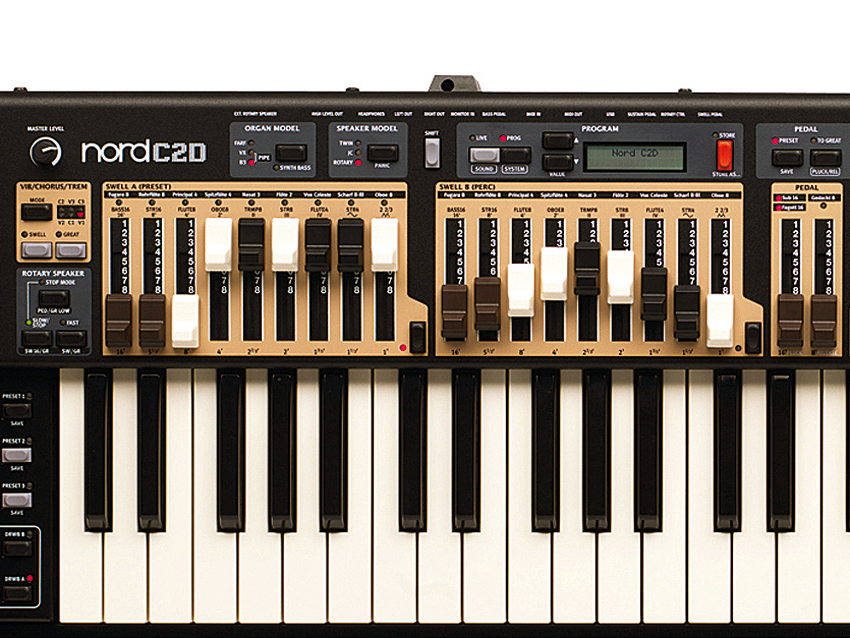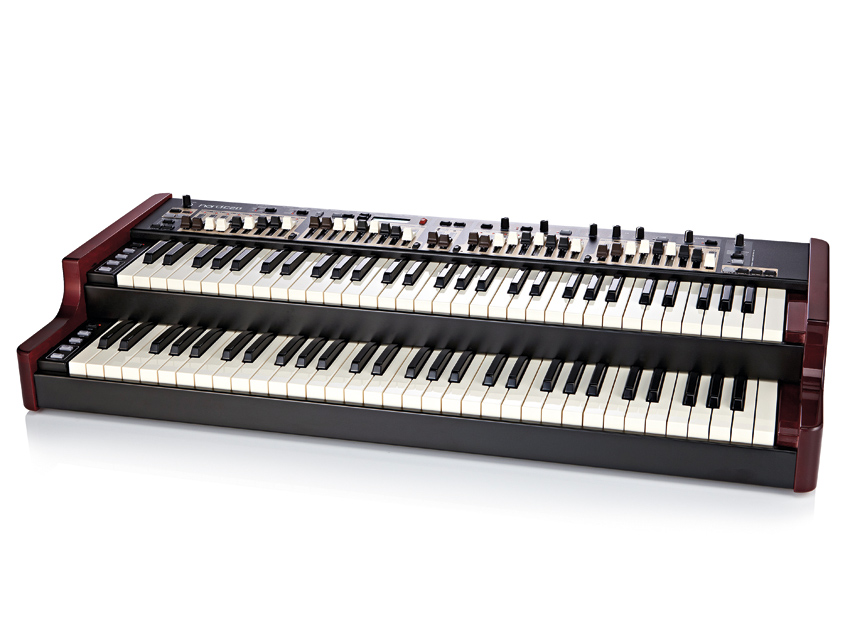MusicRadar Verdict
A significant improvement over the C2, the C2D now appeals to tonewheel purists too.
Pros
- +
Lightweight, with B3-style ergonomics; improved key click, percussion and new 122 rotary speaker model; real drawbars.
Cons
- -
Wider-sounding reverbs and user sound upload would make this even better.
MusicRadar's got your back

Nord C2D

Nord C2D
Almost three years after the launch of the C2, Nord presents us with the C2D.
Yes, the case may be similar (albeit a darker red with a black/yellow panel) but the biggest difference is that the C2D is adorned with a full set of real drawbars, laid out in the main as a Hammond B3 - so diehard organists will immediately feel at home.
"Close your eyes, grab some drawbars and you'd be hard-pushed to tell the C2D from a real B3."
This is something that has been sorely missed on Nords of the past, at least by Hammond purists, and so for them the C2D is now a hugely viable B3 alternative, not just in terms of sound but, perhaps even more importantly, authentic playability.
Grabbing drawbars is an integral part of the tonewheel organ playing experience and, as great as Nord's button/LED drawbar system is, you just can't beat the real thing. The four sets of drawbars (two for each manual and one set of pedal drawbars) also feel like those on a real B3 too, which adds to the overall experience.
Close your eyes, grab some drawbars and you'd be hard-pushed to tell the C2D from a real B3, save for the air from the Leslie blowing your hair.
Key changes
So what else has changed? Well, the keybed feels pretty much the same as the C2, a little stiffer than a real Hammond but nonetheless very playable and easy to control - note that the springs do slacken off a little once played in. The space either side of the control panel on the C2 is now gone, so there's no room to perch your laptop anymore, but that's no biggie.
Want all the hottest music and gear news, reviews, deals, features and more, direct to your inbox? Sign up here.
The preset controls (three per manual) are now conveniently positioned down the left-hand side of the keyboard for easy access, though it would have been great if the rotary controls had been squeezed in by the lower manual too, as if you don't shell out for the optional half-moon rotary switch (£126 inc vat) you have to reach up to the main panel to change the rotary speed - which is quite a stretch. The half-moon switch is therefore a must, so factor that into your budget - it really should be standard on a premium instrument such as this.
Other changes include the very welcome addition of a proper LCD screen, rather than the simple red dot matrix display. You can now give your presets proper names and change system settings much more easily than referring to the cryptic lookup table found on the C2 and this really helps the general workflow.
The upper manual and control panel has also been slightly tilted to aid playing and tweaking and this makes a nice difference when playing and using the drawbars. Also, for those that still prefer the old-style Nord button drawbars/LEDs, the C2 is still being produced alongside the C2D priced at £2,199 inc VAT.
Sonic boon
The sound engine remains largely the same as the C2, and the delay and three-band EQ remain, but there are some significant additions including a super-realistic new key click model and improved percussion model, both of which really stand up admirably next to our real B3. A new Leslie 122 model (close-miked and distance-miked) is also a very useful addition to the 145 model already on board and this really broadens the scope of the C2D's sonic capabilities.
Let's not forget the killer pipe organ samples either, which when coupled with the five onboard reverb emulations, coupler modes and tremulants transport you into vast cathedrals or small churches, plus the Vox and Farfisa emulations, still right up there in terms of playability and authenticity.
We still love the synth bass mode that turns the lower octaves of the bottom manual into a synth bass with variable pluck and release. It would be nice to have a resonant filter, different waveforms and the ability to use the whole of the five octaves as a bass synth, but you can't have everything.
If you wish to get deeper with the B3 model there are three vintages of tonewheel emulation available too, ranging from clean to downright dirty, plus you can tweak the balance of the bass/treble rotors and acceleration.
Real deal
For most people, it will be the B3 emulation that gets the most use and it's here where the C2D really hits a home run. It just oozes authenticity on every level and even staunch B3ists will surely be impressed by the feel and sound.
Not only that, it integrates well with most midi systems. Sure, £2,599 isn't cheap but when you consider how authentic the C2D sounds, plus its portability and now how much more playable it is with real drawbars, it's pretty hard to imagine how it could actually be improved as a B3 emulator, save for perhaps some wider-sounding reverbs and a rotary model with more wind/belt noise, (plus user sound upload would be nice too, like on the Hammond SK2).
However, when you consider you can also plug in a real Leslie speaker and add the Nord Pedal Keys 27 pedalboard too, this is as complete a B3 emulator as you could wish for.